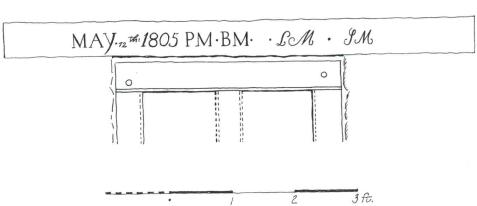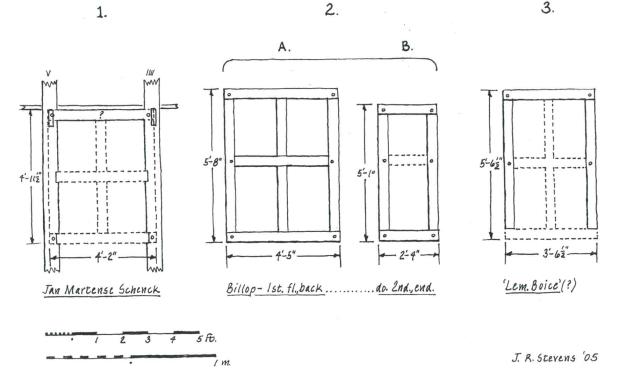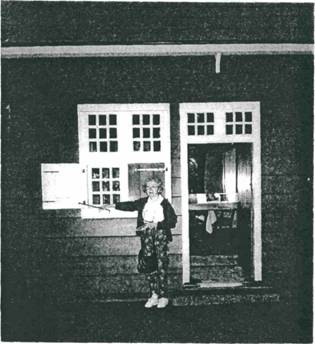HVVA
NEWSLETTER, January 2006
(Click
on graphics/photos for larger view)
HVVA Newsletters
EVIDENCE OF CROSS-WINDOWS IN DUTCH-AMERICAN HOUSES:
The cross-window (kruizkozijn) was the standard window form used
in northern Europe in the better class of house. The particular
form of it used by the Dutch, came to North America with them in
the early 17th century. Typically, the upper two (of four) openings
in the frame were glazed flush with the outside of the frame. The
top edges of the leaded glass panels were housed in a groove cut
into the underside of the head of the frame. The glass panels were
stiffened at each horizontal division in the glazing by means of
iron rods (guard bars) attached to the lead cames by wires soldered
to the cames and twisted together around the iron rods. The ends
of the iron rods were flattened, and attached to the frame with
small nails. Sometimes, hinged casements, glazed in the same way
as the upper openings, were fitted on the inside to the lower openings.
The lower openings also had external hinged shutters.
A relatively small number of examples of this type of window are
know to survive. The following are known to the writer, and it can
be hoped that evidence of others may yet be found.
1. Jan Mark-use Schenck house, c. 1670? This timber-framed
house formerly stood in the Flatland section of Brooklyn, next to
a watermill. It was acquired by the Brooklyn Museum in 1952 and was
dismantled in that year by the E. W. Howell Company (which also,
later, did much of the restoration at Old Bethpage Village Restoration).
The parts of the Schenck house were stored under a highway until
1962 when funds became available to reconstruct the house inside
the museum. Unfortunately, a leak from the roadway degraded some
of the timbers of the house, and in particular the wall posts III,
IHI, V (west wall toward the south end) that had formed the sides
of a transomed doorway and a cross-window. The head of the window
survives (or is it possibly the transom?). The head, transom and
sill were morticed into the wall posts IIII and V that formed the
jambs of the window. The transom of the doorway also survives. Degradation
from water damage to these elements is indicated in the field notes
prepared by Ian Smith for the Brooklyn Museum. The restoration of
the house was largely in the hands of the late Daniel M. C. Hopping
with some input from Henk J. Zantkuyl. (See Dutch Vernacular
Architecture in North America, 1640-1830 [hereafter
D.V.A./N.A.] PI. 17, 41)
2A. Christopher Billop (Conference) house, c. 1680?
This stone house stands at the southern tip of Staten Island. It
survives as an anomaly in the area of Dutch settlement in being two
stories in height, with a center hall. Because it was built for an
Englishman, there are some Ang-licizations, such as the use of plain
tiles on the roof, (instead of pantiles) and possibly, outward-opening
casements on the windows as will be discussed. The only other early
'mansion' comparable with the Billop house is the Ariaantje
Coeymans house which is about 35 years 'newer'. The Billop house
had cross-windows on both its floors. Those on the second floor were
slightly shorter than the ones on the first floor, however the bottom
openings were the same size in all windows. The facade (west wall)
windows were replaced in the 18th century with double-hung sash windows
that were taller, and somewhat narrower than the original ones. Maybe
about the same time as the front windows were altered, a lean-to
was built across the back of the house (east side) encapsulating
four cross-windows within it, in mostly near-original condition.
These window frames were exposed in the recent past when work was
being done within the lean-to, at which time they were measured and
photographed by William McMillen. Subsequently they were covered
over again. The top openings had been glazed in the Dutch manner,
flush with the outside of the frames, but exceptionally the glazed
panels were stiffened internally with wooden rods set in holes in
the jambs that did not correspond with the horizontal divisions of
the glazing ('saddle bars' in English usage). The inside edges of
the frames are molded, precluding the use of inward-opening casements.
These lower openings could have had external shutters in the Dutch
style- or possibly outward-opening casements as was usual in a British
context? (See D.V.A./N.A., PL 2, 3C)
2B. On the second floor of the house at the south
end, west side there survives in place a half-cross-window (kloosterkozijn)
from which the transom has been removed and double-hung sash inserted,
(see D.V.A./N.A., PL 76E, reconstruction by William McMillen)

3. House identified as 'Lem. Boice'. One-and-a-half
story stone house, earliest section (north end) built in the early
18th century, with a stone and a timber-framed addition, both from
the 18th century. It is located north-west of Kingston, near route
209. A cross-window frame survives in the front (east) wall of the
original part of the house. The transom and mullion were removed
to accommodate double-hung sash. Window sill replaced. The head projects
past the jambs about one inch with a groove in its underside to house
the top lights of leaded glass. The interior details cannot be inspected
because they are covered by later trim. The lintel stone over this
window has a well-cut inscription (initials) and the date 1805. This
house requires further investigation, among other things to determine
the significance of the 1805 date on a building that is obviously
much older than this? This house and its cross-window wasered'
in December, 2005.
Ariaantje Coeymans house, c. 1716. Two-and-a-half
story stone mansion at the north end of the Village of Coeymans,
on the Hudson River south of Albany. It has two rooms on each floor
separated by central hallways in which the original staircase survives
unaltered. Originally, the facade (east side) had cross windows
on the first floor, and mullioned windows (bolkozijn) on the second
floor, as is shown in a lost early drawing of the house. The north
wall had windows flanking a jambless fireplace on the first floor,
and the south wall had windows on the second floor on either side
of a fireplace. The original disposition of windows on the back
(west) wall cannot be determined.
4A. One of the north wall windows- that on the east side of the
first floor fireplace has survived intact except for the leaded
glazing in its top openings. The interior of the frame, and the
insides of the shutters retains the original paint. The frame is
now a yellowish color and may originally have been white (?). The
shutters, of batten construction are painted to look like they
are panelled, with
red margins and dark blue, almost black centers (Prussian blue?)
surrounded by a margin of white corresponding with the moldings
on the battens. While the frame has rabbets for casements, there
is no indication that such were ever fitted. Considering the 'mansion'
status of this house, the absence of casements is something of a
surprise! (see D.V.A./N.A., PL 74A)
4B. In the timber-framed Coeymans
'secondary house', the age of which has not been determined, but
is probably early 18th century, there is a half-cross-window (kloosterkozijn)
in the north side wall which at one point had a fireplace built in
front of it. The east (gable) wall of cross-bond brickwork, originally
had two similar windows, later removed and the openings filled with
brick. The existing unit had its outer surfaced mutilated to facilitate
weatherboarding being applied over it. While the bottom opening has
rabbets for a casement, there is no evidence of one being fitted.
(See D.V.A./N.A., PL 75B)

5. Bevier-EIting house, one-and-a-half story, gable-fronted
stone house built in the 1690's with two additions, the earlier one
built in the 1720's. Located on Huguenot Street in the Village of
New Paltz. The house faces west. In the south wall of the first addition
there is a cross-window frame that had been modified for double-hung
sash by the removal of the transom and mullion. An additional jamb
was added within the opening against the east jamb to reduce the
width of the opening. The original east jamb retains both its shutter
rabbet, and that for the leaded glass. The projecting head is grooved
on the underside for the reception of the glazing in the top openings.
This frame does not have internal rabbets for casements. (See D.V.A./N.A.
PI. 74B, 75A)
6. Pieter Winne house, 1723. One-and-a-half
story timber-framed house covered with weatherboards except
for its partially brick facade (east gable wall)of cross-bond. In
the back (west) wall two studs survive that had formed the jambs
of a cross-window. They are of cedar, the only use of this wood found
in the house. The head of the window was formed by the end anchor
beam. The transom, sill and mullion had been removed. The outer
face of the frame had been cut back to the bottoms of the shutter
rabbets so that weatherboards could be installed over the window
opening, into which a 19th century window had been inserted. Again,
in this house, although interior rabbets were provided for casements,
there is no sign they had ever been fitted. A similar window had
once existed in the brick facade (east) wall. One side of the opening
in the brick survived. The other side had been destroyed when a
later, wider window unit was installed. The top of this window
consisted of the end anchor beam, hi which the mortices for the
jambs and the mullion survive, as also the groove to house the
top edges of the leaded glazing. This groove runs the whole length
of the timber and also accommodated the glazing for the transom
of the doorway. (See D.V.A./N.A., PI. 128, 129)
Pieter Bronck house, said to date to 1663 but
probably later. One-and-a-half story gable-fronted stone house.
What is probably a cross-window frame survives in altered condition
in the front (east) wall, just to the south of the centerline.
This frame has been investigated by William McMillen, but certain
details are obscured by the later addition of trim pieces, inside
and out. The opening to the north of this window originally was
a transomed doorway which probably was made into a window when
the older stone house was connected to the 1738 Leandert Bronck
house? (See D.V.A./N.A., PI. 9, top left)
John R. Stevens, December 2005
Marion Stevens in front of the
Jan Martense Schenck House
As reconstructed in the Brooklyn Museum
We understand that the house has been disassembled and moved to a
larger room in the museum. Will the wood muntins in the window sash
be replaced with lead cames and iron guard bars as they would have
been in 1670?
Copyright
© 2006.
Hudson Valley Vernacular Architecture. All rights reserved. All
items on the site are copyrighted. While
we welcome you to use the information provided on this web site
by copying it, or downloading it; this information is
copyrighted and not to be reproduced
for distribution, sale, or profit.
